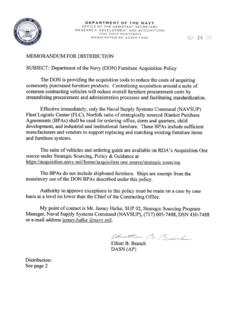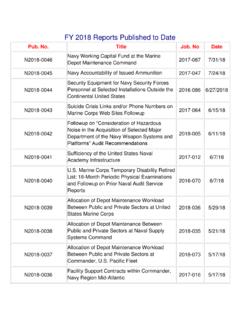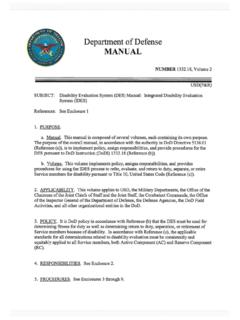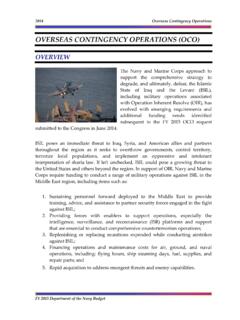Transcription of CONTROLLED UNCLASSIFIED INFORMATION
1 CONTROLLED UNCLASSIFIED INFORMATION . On the front cover: Center: In this July 12, 2020, file photo, smoke rises from the USS Bonhomme Richard (LHD 6), after an explosion and fire onboard the ship at Naval Base San Diego. (AP. Photo/Denis Poroy). Top left: Sailors remove their firefighting ensembles after battling a fire aboard the amphibious assault ship USS Bonhomme Richard (LHD 6) at Naval Base San Diego. (MC1 Jason Navy photo). Top center: Damage onboard USS George Washington (CVN 73) following the May 22, 2008 fire. ( Navy photo). Top right: Smoke billows from the burning USS Miami (SSN 755) May 24, 2012 at the Portsmouth Naval Shipyard in Maine.
2 (Pentagon Channel). Bottom left: Local Jacksonville news coverage of fire onboard USS Iwo Jima (LHD 2). on November 14, 2019. (Aurielle Eady, Lorena Incl n and Action News Jax). Bottom center: The USS Miami (SSN 755) was severely damaged by a fire that broke out on May 23, 2012 in the Portsmouth Naval Shipyard. ( Navy photo, CBS. Boston/AP online article). Bottom right: Federal firefighters assess damage in the hangar bay aboard the amphibious assault ship USS Bonhomme Richard (LHD 6) on July 15, 2020. ( Navy photo). CONTROLLED UNCLASSIFIED INFORMATION . i CONTROLLED UNCLASSIFIED INFORMATION .
3 Introduction On Sunday, July 12, 2020, while in week 88 of a Chief of Naval Operations (CNO) maintenance availability at Naval Base San Diego, a fire broke out onboard the USS Bonhomme Richard (LHD 6) (BHR) in the lower vehicle storage compartment. The fire burned for five days, spread to 11 of 14 decks, and reached temperatures in excess of 1,400 degrees Fahrenheit. The fire resulted in more than $3 billion dollars in damage and a later decision to decommission what would have been one of the Navy's most combat-capable amphibious assault ships. In the aftermath of the BHR fire, the Commanders of Naval Forces Naval Forces Africa, Fleet Forces Command (CUSFFC), and Pacific Fleet (CPF) directed immediate corrective actions.
4 Additionally, the Naval Safety Center (NSC) began a comprehensive historical analysis of major fires onboard Navy ships. The Fleet Commanders released a personal for naval message to all commanders and commanding officers. In the message, the Fleet Commanders directed an immediate assessment of the fleet's fire safety posture, assigned immediate corrective actions, highlighted a requirement for compliance with fire safety principles and regulations, and delineated the need for a constant self-assessment of the fire safety kill chain . Following the BHR fire, the Naval Safety Center (NSC) began a comprehensive historical review of major fires onboard Navy ships.
5 In their analysis, NSC identified multiple recurring trends in the causal factors in 15 shipboard major fire related events over a 12-year period that culminated with the BHR fire. NSC concluded that non- compliance with fire prevention, detection, and response policies and procedures was likely prevalent across the fleets, which led to the NSC Commander's release of a Safety Assurance Letter, via the Vice Chief of Naval Operations (VCNO), to CUSFFC, CPF, the Commander of Naval Sea Systems Command (NAVSEA), and the Commander of Naval Installations Command (CNIC).1. In response to the NSC letter, VCNO tasked the Fleets to work with NAVSEA, Naval Reactors (NR), CNIC and NSC to deep dive the historical record.
6 Specifically, VCNO directed that the Fleet Commanders complete the review in order to understand and address systemic issues underlying the persistence of shipboard fire mishaps and recommend actions that establish the necessary culture and standards required to change Navy fire safety outcomes in an enduring 1. CNO N09F ltr Ser 5100/Code 00 25 Jan 21, Subj: DRIVING ENDURING CHANGE IN SHIPBOARD FIRE SAFETY OUTCOMES. 2. VNCO ltr Ser N09/21U100500 26 Jan 21, Subj: DRIVING ENDURING CHANGE IN SHIPBOARD FIRE SAFETY OUTCOMES. CONTROLLED UNCLASSIFIED INFORMATION . 1. CONTROLLED UNCLASSIFIED INFORMATION .
7 VCNO's letter specifically highlighted the following: x Recurring hazards despite risk controls implemented x Consistent under-reporting x Acceptance of excessive numbers of precursor problems and events x Rigorous assessment of historical performance required VCNO tasked the Fleet Commanders with examining the 15 major fire events to answer the following: x Why actions put in place following major shipboard fires, such as implementation of reference (b) [NAVSEA Technical Publication S0570-AC-CCM-010/8010. Industrial Ship Safety Manual for Fire Prevention and Response (8010)]
8 ] of the NSC letter, and related guidance did not sustainably achieve the desired outcome x Why appropriate unit level standards were not consistently sustained relative to material control, cleanliness, and fire response readiness x Why oversight from the ship's chain of command did not reliably identify and correct unit level performance gaps and noncompliance x Why reporting mechanisms were not effective in providing a view of the actual risk posture x Why lessons learned from other adverse performance events were not accelerated into fire safety doctrine and practice x Why independent oversight organizations, such as NSC, were not effective in identifying the problems for Fleet action With VCNO's specific questions as a guide, the Major Fires Review (MFR)
9 Set out to identify any systemic issues regarding the standards, culture and environment that are driving a lack of discipline in stowage and cleanliness; noncompliance with applicable governance; or an insufficient level of fire safety readiness. The MFR team did not limit the review to the historical incidents but also conducted a series of site visits and unit assessments in order to evaluate the current state of compliance with fire safety requirements and overall posture of the fleet. CONTROLLED UNCLASSIFIED INFORMATION . 2. CONTROLLED UNCLASSIFIED INFORMATION . In the course of the review, the MFR identified several underlying issues to include.
10 X Lessons learned are not effectively collected and are lost over time due to an ineffective and inconsistent process to collect, analyze, disseminate, and enact critical INFORMATION and corrective actions to include the process to conduct shipboard safety investigations x Ineffective Damage Control Board of Directors (DCBoD) actions and processes for damage control improvements across the fire safety kill chain of prevention, detection, and response x A lack of appreciation for the hazards associated with significant transitions, especially during maintenance periods, and insufficient management of the associated risk x Unmitigated threats and vulnerabilities, in particular.










